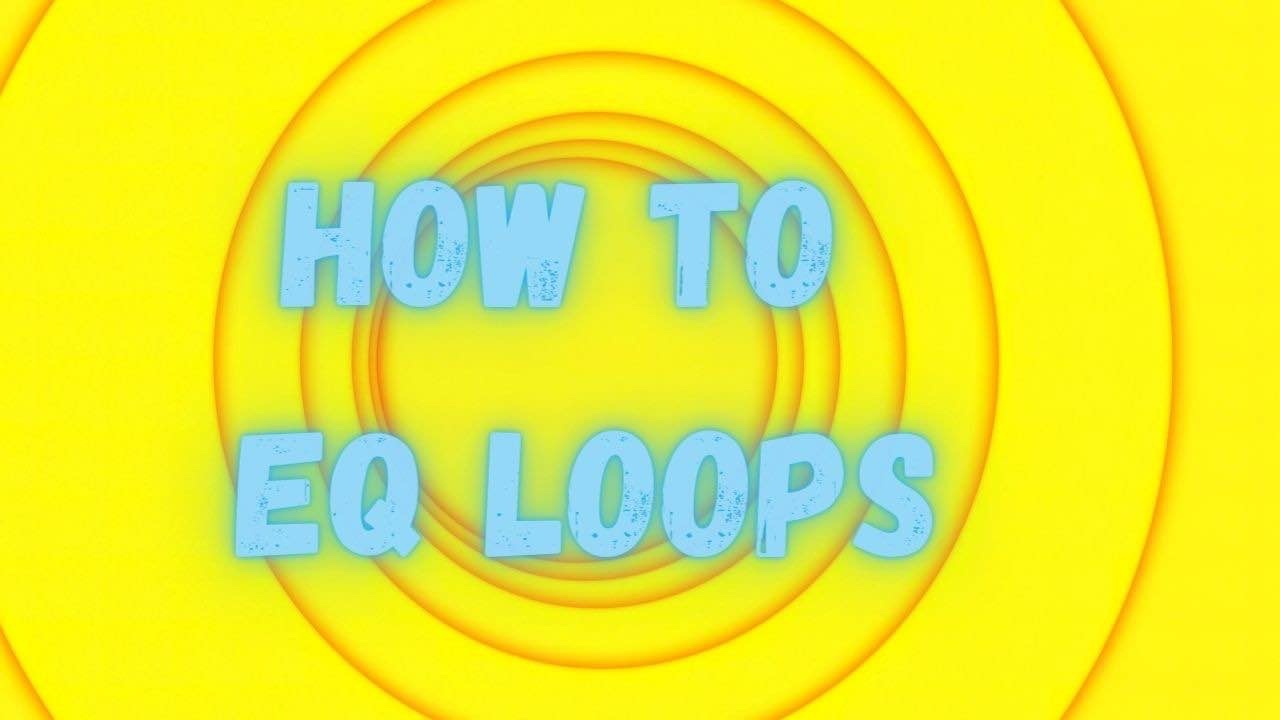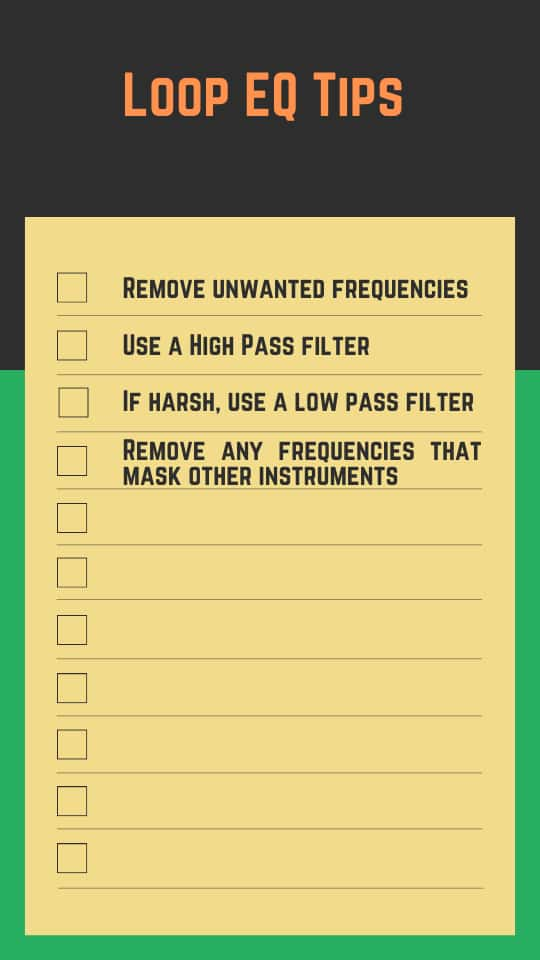How to EQ Loops

EQ is one of the most important tools in any mix engineer’s tool kit. In a way, it’s a perfect balance between science and art. You can use EQ subtly to make slight adjustments or make dramatic, sweeping changes to alter your mix.
Note that before we dive in and talk about EQing certain instruments, it’s important to note that no EQ advice should ever be taken at face value. For that reason, we’ll be looking at general tips to help clean up your mixes and give them more clarity.
Note: this article may contain affiliate links, which mean that I receive a commission for any purchases you make, at no added cost to you.
How to EQ Loops
Loops are often full-bodied recordings that are meant to sound good on their own. This means that they can occupy a good amount of the EQ range. For example, you might have a hi-hat loop that has a lot of bottom end, as the bottom-end sounds good when it’s not paired up with a full kit in a mix. However, the low-end might take up precious headroom when all is said and done.
This is where subtractive EQ comes in. When EQing loops, I often ask myself,
What role is this loop taking and what frequencies doesn’t it need to fulfill that role?

What is a Drum Loop?
A drum loop is a repeated snippet of audio material, typically labeled by BPM. Loops come in all shapes and sizes. For example, you might have a four-bar drum loop with the full kit, including kick, snare, and hi-hat. On the other hand, you might have an eight-bar loop with only snare.
Drum loops can be stacked and sliced up to fit in arrangements. One of our favorite places to find drum loops is on Splice.
By the way, here are a list of some of the best drum loop packs available. And here are some of the 11 best sites for free loops and free samples.
Should You Use EQ for Professional Loops?
Professional loops are often meant to sound good on their own. When you’re looking through a loop library, you’ll naturally download the sounds that impress you the most. However, this means that certain sounds will have far more frequency content than they actually need when in a mix.
For example, you might download a drum loop that sounds great on its own with tons of mid-range and body around 500Hz. However, when you put it in the mix, the mid-range gets in the way of other mid-range instruments, such as guitar and vocals. In this case, you’d use subtractive EQ.
Tips for EQing Drum Loops
I often consider my low-end first when EQing drum loops. If there’s a lot of unnecessary bottom-end or rumble in my drum loops, I’ll use a high-pass filter or low-shelf to remedy it. My first goal is to use puzzle piece EQ to fit my drum loop with my bass.
Then, I’ll consider how it’s feeling with the rest of the mix. If it’s a busy mix, I might want to reduce the low mid-range to make room for other instruments.
Need more help? Check out my full article on how to EQ drums.
Tips for EQing Bass Guitar Loops
When EQing bass loops, you have to ask what role the bass plays.
For starters, consider the low-end. Should the bass sit above or below your kick drum? If above, you may consider rolling off the low-end with a high-pass filter. The low E on a bass guitar is at 42 Hz, meaning you can usually roll off to that frequency point without doing any harm.
Next, consider how it sounds in the mix. If if needs more low-end body, considering boosting anywhere from 80 to 100 Hz with a wide Q. If it needs more bite and presence, consider boosting around 800 Hz with a wide Q.
Need more help? Check out my full article on How to EQ bass guitar!

Tips for EQing Rhythm Percussion Loops
Percussion loops don’t often need tons of low-end, especially when paired with drums and bass. The first thing I often find myself doing is using a high-pass filter to get rid of unnecessary low-end below 100Hz. Depending on the type of percussion, I might take it higher.
Next, I’ll listen for high-end. If I already have a ton of high-frequency instruments in my mix, such as cymbals or high synths, I might be able to chop a bit of high-end off my percussion loops with a high-shelf or low-pass filter.
Need more help? Check out my full article on how to EQ percussion?
Tips for EQing Guitar Loops
Guitars are mid-range instruments, meaning you can often cut off the “crust” to get the best sound. Depending on your mix, you’ll likely be able to high-pass your guitar up to 80 Hz without doing any damage to make room for the bass and kick.
For distorted guitars especially, I often like to low-pass down to around 10kHz to get rid of that harsh high-end. You might even bring this low-pass down to as much as 7kHz, depending on the sound.
Need more help? Check out my full article on Electric guitar EQ tricks.
Tips for EQing Piano Loops
Pianos are full-bodied instruments, meaning they often need a bit of subtractive EQ when mixing. I often like to start with a good high-pass filter to get rid of unecessary low-end, making room for the bass and kick.
Depending on the piano loop, I might even use an analog-style EQ to boost the top-end and get a bit more sparkle out of my piano. A high-shelf around 10kHz works brilliantly.
Need more help? Check out my full article on EQing piano.
Tips for EQing Synth Loops
With so many different types of synth sounds out there, there is no way I could give you an EQ method that would work for all of them. I would just tell you to consider the role of the synth.
Is it a background pad?
If so, cut a bit of high-end to push it toward the back of the mix.
Is it a lead?
If so, cut some low-end and give it a presence boost anywhere from 1-3kHz to help it pop through the mix.
Tips for EQing Vocal Loops
When EQing vocal loops, it’s a good idea to get rid of low-end before anything. The human voice doesn’t have a ton of useful information below 100 Hz. Depending on how well the loop was recorded, you may or may not need to get rid of low-mid information from around 100 to 500Hz.
If your vocal loop isn’t sitting on top of the mix properly, you can try giving it a presence boost anywhere from 2-3kHz or an “air” boost with a high-shelf from around 10kHz and up.
Need more help? Check out my full article on how to EQ vocals!
How to use EQ Guides
To help you get the most out of your EQ plugins, we've put together these detailed guides to teach you how to use EQ on some of the most popular instruments.
From a Frustrated Producer in a Ragtag Bedroom Studio to Major Placements on TV Earning $1,000s!
My name is Evan, and I've been making music since around 3rd grade. I'm from San Diego, California, but I've lived in Washington, DC for the last 20 years.
While I still have a full-time day job, I have created systems that have allowed me to produce dozens of songs a year in my spare time.
My songs have been on Netflix, TV shows like the 90 Day Fiance, an award-winning indie film, and NPR’s “All Thing Considered.” They've also been streamed millions of times.
In addition to being a music producer, I am passionate about teaching people how they can make professional-sounding music and earn money licensing it, all in their spare time.
Thousands of musicians, like yourself, have trusted me to guide their musical journey. My YouTube videos have been watched nearly a million times. And my story has been in Forbes, Side Hustle Nation, and the Side Hustle School.






